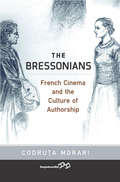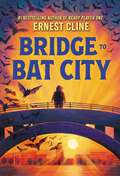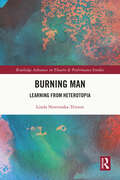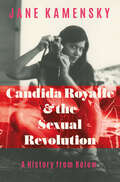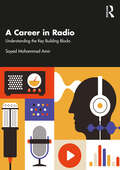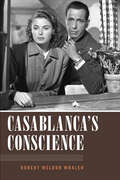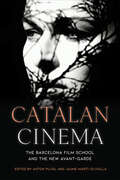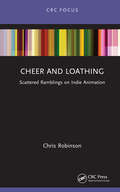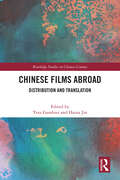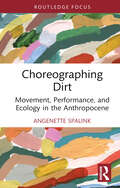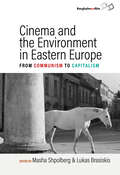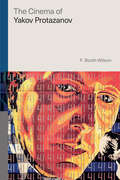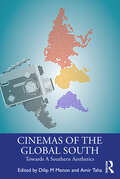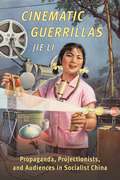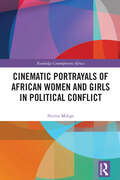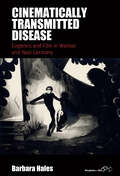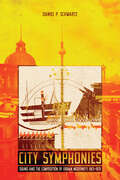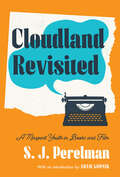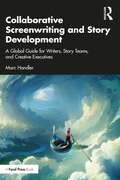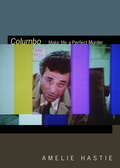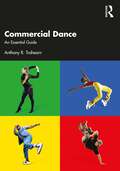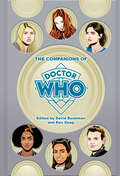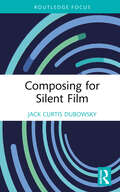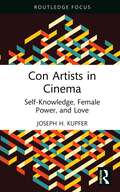- Table View
- List View
The Bressonians: French Cinema and the Culture of Authorship
by Codruţa MorariHow should we understand film authorship in an era when the idea of the solitary and sovereign auteur has come under attack, with critics proclaiming the death of the author and the end of cinema? The Bressonians provides an answer in the form of a strikingly original study of Bresson and his influence on the work of filmmakers Jean Eustache and Maurice Pialat. Extending the discourse of authorship beyond the idea of a singular visionary, it explores how the imperatives of excellence function within cinema’s pluralistic community. Bresson’s example offered both an artistic legacy and a creative burden within which filmmakers reckoned in different, often arduous, and altogether compelling ways.
Bridge to Bat City
by Ernest ClineFrom #1 New York Times bestselling author Ernest Cline comes a mostly true tall tale about an unexpected friendship between a young girl and a music-loving colony of bats. After losing her mother, thirteen-year-old Opal moves in with her uncle Roscoe on the family farm. There, Opal bonds with Uncle Roscoe over music and befriends a group of orphaned, music-loving bats. But just as the farm is starting to feel like home, the bats&’ cave is destroyed by a big mining company with its sights set on the farmland next. If Opal and the bats can fit in anywhere, it&’s the nearby city of Austin, home to their favorite music and a host of wonderfully eccentric characters. But with people afraid of the bats and determined to get rid of them, it&’ll take a whole lot of courage to prove that this is where the bats—and Opal—belong.
Burning Man: Learning from Heterotopia (Routledge Advances in Theatre & Performance Studies)
by Linda Noveroske-TrittenThis book centres on a philosophical analysis of creative acts in the Burning Man Festival and their roles in wider social change. With particular focus on the Ten Principles of Burning Man, Linda Noveroske posits a re-interpretation of common notions of “self” and “other” as they apply to identity, difference, and the ways that these personal impulses ripple outward from changing individuals into changing societies. Such radical re-imagination of ideology can be most powerful when it occurs in spaces of otherness, of heterotopia. This study casts Burning Man as a heterotopia to not only destabilizes what we think we know about visual art, performance, and creative encounters, but also bring these acts into an attitude of immediacy that facilitates previously unimagined behaviour and opens out artistic drive into the unknown. This book would be of value for scholars and practitioners in Performance Studies, Theatre and Dance, Art History, Psychology, Phenomenology, Architecture and Urban Studies.
Candida Royalle and the Sexual Revolution: A History from Below
by Jane KamenskyAcclaimed historian Jane Kamensky chronicles an indelible twentieth-century American life—and offers an entirely new understanding of the so-called sexual revolution. Whether in front of the camera or behind it, Candice Vadala understood herself as both an artist and an entrepreneur. As Candida Royalle (1950–2015)—underground actress, porn star, producer of adult movies, and staunch feminist—she made a business of pleasure. She helped crystalize the broader hedonistic turn in American life in the second half of the twentieth century: a period when the rules of sex were rewritten; when the white-hot “sex wars” cleaved feminism and realigned American politics; when Big Freud, Big Drugs, and Big Porn all came into looming focus; when the sex industry of the 1970s and ’80s radically upended conventional understandings of law, technology, culture, love, and human desire. The sexual revolution was Royalle’s war—even when other avowed feminists exited the field or became her opponents—and pornography emerged as the arena in which she would wage it. With the founding of her adult film company, Femme Productions, in 1984, Royalle became an owner of the means of pornographic production, infusing her sets with the ideals of labor feminism. On-screen and off-, she was, by turns, exuberant and thoughtful, self-possessed and gleefully shameless. A trailblazer who lived along the cultural fault lines of her generation, she danced at Woodstock, marched for women’s liberation, survived the AIDS crisis, and became a talk show regular, interviewed by Phil Donahue, Dr. Ruth Westheimer, Morton Downey Jr., Jane Pauley, and many others. As a performer, director, producer, and writer, she moved the needle of her industry. But she never transcended the politics of pleasure. With full access to Royalle’s remarkable archive, historian Jane Kamensky has spent years examining the intersection of Royalle’s life with the clashes that have defined her era—and ours. Deeply informed by these never-before-studied materials, Kamensky explodes the conventions of biography, with its assumptions about who makes history and how. Written with cinematic verve, Candida Royalle and the Sexual Revolution evokes Royalle’s times in their broadest contours as Kamensky traces the rise of an improbable heroine who broke the mold and was herself broken in turn.
A Career in Radio: Understanding the Key Building Blocks
by Sayed Mohammad AmirThis book gives an overview of the development, significance, and impact of radio as a medium of mass communication in modern society. It provides a thorough understanding of the various wings and functionaries of the radio industry. The book also covers aspects of commercial radio, the basics of understanding the pulse of radio listeners, formatting radio programming, making an effective sales pitch and producing great commercials to exhaustive advice on presenting a show, appearing for interviews, and public speaking. It also gives insight into the changes brought in by technology in terms of traditional radio broadcasts, such as digital radio, highlighting its advancements in audio quality and the diversity of programming options available, and satellite radio, subscription-based services, and exclusive access to specialised programming. An outcome of the author’s vast experience of working as a radio jockey and programme manager for over 17 years, his book will be an ideal textbook for undergraduate and postgraduate students of journalism and mass communication, taking courses on radio, audio and podcasting, media production and digital media. Additionally, this book will be an invaluable companion to existing radio professionals as a resource-book for their professional development.
Casablanca's Conscience
by Robert Weldon WhalenA new look at a beloved classic film that explores the philosophical dynamics of CasablancaCelebrating its eightieth anniversary this year, Casablanca remains one of the world’s most enduringly favorite movies. It won three Academy Awards for Best Picture, Best Director, and Best Adapted Screenplay. It is still commonly quoted: “We’ll always have Paris” and “Here’s looking at you, kid” And who can forget, “You must remember this…a kiss is just a kiss.” Yet no one expected much to come of this little film, certainly not its blockbuster stars or even the studio producing it. So how did this hastily cranked-out 1940s film, despite its many limitations, become one of the greatest films ever made? How is it that year after year, decade after decade, it continues to appear in the lists of the greatest movies ever produced? And why do audiences still weep when Rick and Ilsa part? The answer, according to Casablanca’s Conscience, is to paraphrase Rick, “It’s true.”Much has already been written about the film and the career-defining performances of Bogart and Bergman. Casablanca is an epic tale of love, betrayal, and sacrifice set against the backdrop of World War II. Yet decades later, it continues to capture the imagination of filmgoers. In Casablanca’s Conscience, author Robert Weldon Whalen explains why it still resonates so deeply. Applying a new lens to an old classic, Whalen focuses on the film’s timeless themes—Exile, Purgatory, Irony, Love, Resistance, and Memory. He then engages the fictional characters—Rick, Ilsa, and the others—against the philosophical and theological discourse of their real contemporaries, Hannah Arendt, Dietrich Bonhoeffer, and Albert Camus. The relationships between fictional and historical persons illuminate both the film’s era as well as perennial human concerns. Both the film and the work of the philosophers explore dimensions of the human experience, which, while extreme, are familiar to everyone. It’s the themes that resonate with the viewer, that have sustained it as an evergreen classic all these years.
Catalan Cinema: The Barcelona Film School and the New Avant-Garde (Toronto Iberic)
by Anton Pujol Jaume Martí-OlivellaCatalan Cinema offers a theoretical reading of the most relevant cinematic productions to emerge from Catalonia in the last twenty years. The essays in this collection examine cinema in relation to the Escola de Barcelona (The Barcelona School), a group of cinema directors that drew inspiration from British pop-art, Free Cinema, and the Nouvelle Vague to create works that defied and challenged the Franco dictatorship. Highlighting the aesthetic, social, and political elements of Catalan cinematography, contributors to this volume explore what young directors have in common with works created by more notable directors such as Joaquim Jordà, Jacinto Esteva, Jordi Grau, and Pere Portabella. Catalan Cinema focuses on the importance of modern production and its connection with the avant-garde and underground cinema from the Barcelona School. Establishing a cinematic genealogy, the volume ultimately questions if Catalan cinema’s own push for self-expression may be interpreted as a connection to Catalonia’s current drive for independence.
Cheer and Loathing: Scattered Ramblings on Indie Animation (Focus Animation Ser.)
by Chris RobinsonOne of the most acclaimed writers in animation returns with this informal sequel to his previous books on indie animation, Unsung Heroes of Animation, Animators Unearthed, and Mad Eyed Misfits. In this collection, award-winning writer, Chris Robinson, looks at a wide range of films, topics (sex, censorship, cultural politics, programming, felt, gifs, VR, dogs) and filmmakers (Masaaki Yuasa, Xi Chen, Gil Alkabetz, Jacques Drouin, Bordo, Rosto, Joaquín Cociña, Cristóbal León, George Schwizgebel, Lizzy Hobbs, Andreas Hykade, Leah Shore, and many others). Eclectic, brief, fiery, and opinionated, Robinson’s gonzo-tinged writing will amuse, confuse, annoy, and maybe even inspire while, hopefully introducing readers to the wonders of independently-produced animation.
Chinese Films Abroad: Distribution and Translation (Routledge Studies in Chinese Cinema)
by Yves Gambier Haina JinThis book examines Chinese films made and shown abroad roughly between the 1920s and the 2020s, from the beginning of the international exchange of the Chinese national film industry to the emergence of the concept of soft power.The periodisation of Chinese cinema(s) does not necessarily match the political periods: on the one hand, the technical development of the film industry and the organisation of translation in China, and on the other hand, official relations with China and translation policies abroad impose different constraints on the circulation of Chinese films. This volume deals with the distribution and translation of films from mainland China, Taiwan, Hong Kong, and the Chinese diaspora. To this end, the contributors address various issues related to the circulation and distribution of Chinese films, including co- productions, agents of exchange, and modes of translation. The approach is a mixture of socio- cultural and translational methods. The data collected provides, for the first time, a quantitative overview of the circulation of Chinese films in a dozen foreign countries.The book will greatly interest scholars and students of Chinese cinema, translation studies, and China studies.
Choreographing Dirt: Movement, Performance, and Ecology in the Anthropocene (Routledge Studies in Theatre, Ecology, and Performance)
by Angenette SpalinkThis book is an innovative study that places performance and dance studies in conversation with ecology by exploring the significance of dirt in performance. Focusing on a range of 20th- and 21st-century performances that include modern dance, dance-theatre, Butoh, and everyday life, this book demonstrates how the choreography of dirt makes biological, geographical, and cultural meaning, what the author terms "biogeocultography". Whether it’s the Foundling Father digging into the earth’s strata in Suzan-Lori Park’s The America Play (1994), peat hurling through the air in Pina Bausch’s The Rite of Spring (1975), dancers frantically shovelling out fistfuls of dirt in Eveoke Dance Theatre’s Las Mariposas (2010), or Butoh performers dancing with fungi in Iván-Daniel Espinosa’s Messengers Divinos (2018), each example shows how the incorporation of dirt can reveal micro-level interactions between species – like the interplay between microscopic skin bacteria and soil protozoa – and macro-level interactions – like the transformation of peat to a greenhouse gas. By demonstrating the stakes of moving dirt, this book posits that performance can operate as a space to grapple with the multifaceted ecological dilemmas of the Anthropocene. This book will be of broad interest to both practitioners and researchers in theatre, performance studies, dance, ecocriticism, and the environmental humanities.
Cinema and the Environment in Eastern Europe: From Communism to Capitalism
by Masha Shpolberg and Lukas BrasiskisThe annexation of Eastern Europe to the Soviet sphere after World War II dramatically reshaped popular understandings of the natural environment. With an eco-critical approach, Cinema and the Environment in Eastern Europe breaks new ground in documenting how filmmakers increasingly saw cinema as a tool to critique the social and environmental damage of large-scale projects from socialist regimes and newly forming capitalist presences. New and established scholars with backgrounds across Europe, the United States, and Australia come together to reflect on how the cultural sphere has, and can still, play a role in redefining our relationship to nature.
The Cinema of Yakov Protazanov (Global Film Directors)
by F. Booth WilsonBest known for Aelita (1924), the classic science-fiction film of the Soviet silent era, Yakov Protazanov directed over a hundred films in a career spanning three decades. Called "the Russian D.W. Griffith" in the 1910s for his formative role in the first movies in the last years of the Russian Empire, he fled the Civil War and maintained a successful career in Europe before making an unusual decision to return to Russia now under Soviet power. There his films continued their remarkable success with audiences undergoing a bewildering and often brutal revolutionary transformation. Rather than treating him as an indistinct, if capable craftsman, The Cinema of Yakov Protazanov argues that his films are suffused with a unique creative vision that reflects both his mindset as a traditional Russian intellectual and his experience of dislocation and migration after 1917. As he adapted his films to revolutionary culture, they intermingled different voices and reinterpreted his past work from a disavowed era. Offering fresh perspectives of Protazanov’s films, the book will give readers a new appreciation of his career. The book offers a uniquely valuable vantage point from which to explore how cinema reflected a society in transformation and a seminal moment in the development of cinematic art.
Cinemas of the Global South: Towards a Southern Aesthetics
by Dilip M Menon Amir TahaThis book engages with the idea of the Global South through cinema as a concept of resistance; as a space of decolonialisation; and as an arena of virtuality, creativity and change. It opens up a dialogue amongst scholars and filmmakers from the Global South: India, Nigeria, Colombia, Brazil, South Africa, and Egypt.The essays in the volume approach cinema as an intertwined process of both production and perception not divorced from the economic, social, political and cultural. They emphasise film as a visual medium where form, structure and content are not separable. Through a wide array of film-readings, the authors explore the concept of a southern cinematic esthetics, in particular, and the concept of the Global South in general.The volume will be of interest to scholars, students and researchers of film and media studies, critical theory, cultural studies and Global South studies.
Cinematic Guerrillas: Propaganda, Projectionists, and Audiences in Socialist China
by Jie LiHow might cinema make revolution and mobilize the masses? In socialist China, the film exhibition network expanded from fewer than six hundred movie theaters to more than a hundred thousand mobile film projectionist teams. Holding screenings in improvised open-air spaces in rural areas lacking electricity, these roving projectionists brought not only films but also power generators, loudspeakers, slideshows, posters, live performances, and mass ritual participation, amplifying the era’s utopian dreams and violent upheavals.Cinematic Guerrillas is a media history of Chinese film exhibition and reception that offers fresh insights into the powers and limits of propaganda. Drawing on a wealth of archives, memoirs, interviews, and ethnographic fieldwork, Jie Li examines the media networks and environments, discourses and practices, experiences and memories of film projectionists and their grassroots audiences from the 1940s to the 1980s. She considers the ideology and practice of “cinematic guerrillas”—at once denoting onscreen militants, off-the-grid movie teams, and unruly moviegoers—bridging Maoist iconography, the experiences of projectionists, and popular participation and resistance. Li reconceptualizes socialist media practices as “revolutionary spirit mediumship” that aimed to turn audiences into congregations, contribute to the Mao cult, convert skeptics of revolutionary miracles, and exorcize class enemies.Cinematic Guerrillas considers cinema’s meanings for revolution and nation building; successive generations of projectionists; workers, peasants, and soldiers; women and ethnic minorities; and national leaders, local cadres, and cultural censors. By reading diverse, vivid, and often surprising accounts of moviegoing, Li excavates Chinese media theories that provide a critical new perspective on world cinema.
Cinematic Portrayals of African Women and Girls in Political Conflict (Routledge Contemporary Africa)
by Norita MdegeThis book provides an interdisciplinary exploration of the cinematic representations of the experiences of African women and girls in situations of political conflict. The role of cinema is important in providing information about the situation of women and girls in situations of political conflict, and the main characters often also become signifiers of wider social, political and economic ideas, at both global and local levels. Drawing on fictional and biographical cinematic representations, this book considers films covering a range of different regions, experiences, historical periods and other contexts, to draw a nuanced picture of African women and girls who participate in or are affected by African political conflicts. The films are analysed using a decolonial feminist cultural approach, which combines cultural approaches, African feminisms and the contrapuntal method to ensure an inter-textual, intersectional and decolonial examination. The book engages with multiple themes and topics, including nationalism, nation-building, neocolonialism, memory, history, women’s and girls’ agency and activism. Through these themes and topics, the book explores how the films represent African women’s and girls’ agency in relation to their participation in social, economic and political activities. This book will make a significant contribution to literature focused on African women and girls within politics, conflict studies and film studies.
Cinematically Transmitted Disease: Eugenics and Film in Weimar and Nazi Germany (Film Europa #28)
by Barbara HalesPropaganda played an essential role in influencing the attitudes and policies of German National Socialism on racial purity and euthanasia, but little has been said on the impact of medical hygiene films. Cinematically Transmitted Disease explores these films for the first time, from their inception during the Weimar era and throughout the years to come. In this innovative volume, author Barbara Hales demonstrates how medical films as well as feature films were circulated among the German people to embed and enforce notions of scientific legitimacy for racial superiority and genetically spread “incurable” diseases, creating and maintaining an instrumental fear of degradation in the German national population.
City Symphonies: Sound and the Composition of Urban Modernity, 1913–1931
by Daniel P. SchwartzCinema scholars categorize city symphony films of the 1920s and early 1930s as a subgenre of the silent film. Defined in visual terms, the city symphony organizes the visible elements of urban experience according to musical principles such as rhythm and counterpoint.In City Symphonies Daniel Schwartz explores the unheard sonic dimensions of these ostensibly silent films. The book turns its ear to the city symphony as an audible phenomenon, one that encompasses a multitude of works beyond the cinema, such as musical compositions, mass spectacles, radio experiments, and even paintings. What these works have in common is their treatment of the city as a medium for sound. The city is neither background nor content; rather, it is the material through which avant-garde works express themselves. In resonating through the city, these multimedia pieces perform experiments that undermine the borders between sight and sound.Applying an interdisciplinary approach, City Symphonies expands our understanding of the genre, breaking out of the confines of the cinema and onto the street.
Cloudland Revisited: A Misspent Youth in Books and Film
by S. J. PerelmanGathered for the first time: one of America's great humorists revisits the books and movies from his youth—often with some embarrassment—in this complete, 22-piece collectionFrom October 1948 to October 1953, The New Yorker published humorist S. J. Perelman&’s &“Cloudland Revisited&” series: 22 reviews of once-popular books and silent films whose expiration dates had passed. All but forgotten even at the time, they were nonetheless part of Perelman&’s youth and made an indelible mark on him.In the comic genius&’s biting satire they live once again:Gertrude Atherton&’s sensationalist fantasy Black OxenSax Rohmer&’s supervillain blockbuster The Mystery of Dr. Fu-Manchuthe &“underwater&” silent film adaptation of Twenty Thousand Leagues under the SeaEdgar Rice Burrough&’s 1914 novel Tarzan of the Apesand George Barr McCutcheon&’s 1901 historical fantasy novel Graustark—the Game of Thrones of its era—which launched numerous sequels and film adaptations The complete series is collected here for the first time. With self-deprecating humor and frequent embarrassment, Perelman reflects on how rereading and rewatching brings us in contact with how we, like an old book or film, have both changed and remained the same. This paperback includes a tribute to Perelman&’s art by another beloved New Yorker writer, Adam Gopnik.
Clueless: Totally Delicious Recipes Inspired by the Film
by Kim LaidlawClueless comes to the kitchen with this officially licensed cookbook, featuring 50 totally delicious recipes, iconic movie quotes, full-color images from the film, and much more. Use it to make your &’90s-themed gatherings even more legit, or for meal ideas anytime you&’re feeling a little clueless. Witty, charming, privileged Cher Horowitz leads the pack at her Beverly Hills high school in Amy Heckerling&’s cult classic Clueless. Through the eyes of style-obsessed Cher, we join in the fun of makeovers, the rollercoaster ride of crushes and friendships, and the social hierarchy of high school. Inspired by the snacks, drinks, and meals highlighted throughout the film, the Southern California healthy eating craze, and the best of the 1990s, the recipes in this official cookbook are tribute to the adventures and calamities of Cher, Dionne, Tai, Murray, Josh, Travis, and all the rest of our favorite Clueless characters. From take-it-with-you options like Gnarly Skateboarder&’s Breakfast Sandos to homemade versions of snack foods that litter the lunch tables at Cher&’s school (Off-the-Diet Popcorn, anyone?), the recipes in this cookbook bring the personalities and narrative of Clueless to life. Some of the featured recipes include: Beverly Hills Yogurt Parfaits Party in the Valley Pretzel Bites Family Dinner Rosemary Focaccia Gooey Baked Brie with Crudites Total Betty Turkey &“Bacon Experience&” BLTA So-Lo-Cal Chopped Chicken, Avocado, and Herb Salad Totally Not Buggin&’ Baked Goat Cheese Salad with Herb Vinaigrette and Crostini Chuckleheads Asparagus Quiche Grade-Changing Grilled Spinach Pesto Chicken Breasts Extra Credit Steak Caesar Avocado Wrap Tai Lattice Peach Pie Cute Plaid Lemon Sugar Cookies Full-on Monet Raspberry Vanilla Fro-Yo Not-the-Mall-Food-Court Smoothies Root Beer &“Pool Party&” Floats Perfect for families and fans of the film, Clueless: The Official Cookbook is a celebration of the '90s and a tribute to an enduring comedy. So dive in, eat up, and enjoy!
Collaborative Screenwriting and Story Development: A Global Guide for Writers, Story Teams, and Creative Executives
by Marc HandlerThis is a comprehensive guide to teach writing and story development from a collaborative global perspective. This book teaches writers how to take full advantage of emerging opportunities, both locally and globally. With an increasing number of international co-productions and many screenwriters now working collaboratively in writers rooms and development groups, author Marc Handler explains how to work cooperatively with others to break stories, plan seasons, create characters, and build series. To succeed, readers will learn how to give and receive feedback effectively, adapt to the style and constraints of executives and brands, and contribute to the team building process, all within an increasingly global media industry that is in constant flux. This book will help readers develop a global perspective, ensuring that they are prepared for new opportunities as they arise. Marc Handler provides cultural insight and understanding as he describes the fundamentals as well as advanced story skills. This book is essential reading for students taking classes such as Screenwriting Fundamentals, Writing for Film and TV, Introduction to Television Writing, and Advanced Screenwriting, as well as aspiring and early career screenwriters, showrunners, producers, and creative executives.
Columbo: Make Me a Perfect Murder (Spin Offs)
by Amelie HastieFor decades, generations of television fans have been enraptured by Lt. Columbo, played by Peter Falk, as he unravels clues to catch killers who believe they are above the law. In her investigation of the 1970s series cocreated by Richard Levinson and William Link, Amelie Hastie explores television history through an emphasis on issues of stardom, authorship, and its interconnections with classical and New Hollywood cinema. Through close textual analysis, attentive to issues of class relations and connections to other work by Falk as well as Levinson and Link, Columbo: Make Me a Perfect Murder sees American television as an intertextual system, from its origins as a commercial broadcast medium to its iterations within contemporary streaming platforms. Ultimately, Hastie argues, in the titular detective’s constant state of learning about cultural trends and media forms, Columbo offers viewers the opportunity to learn with him and, through his tutelage, to become detectives of television itself.
Commercial Dance: An Essential Guide
by Anthony R. TrahearnThis is an exploration of the vital and rapidly evolving world of Commercial Dance, tracing the evolution and merging of Hip-Hop, Club and Jazz dance styles from the music videos of the early 1980s, to today's huge influence on pop music and dance in a multi-media culture. Chapters including ‘Iconic Moments’ and ‘Main Movers’ contextualise and analyse culturally significant works and choreographers. With direct contributions from an international array of industry leading dancers, choreographers and creatives - including JaQuel Knight (Beyonce’s choreographer), Rich + Tone Talauega (Madonna & Michael Jackson collaborators), Rebbi Rosie (Rihanna’s dancer), Dean Lee (Janet Jackson’s choreographer) and Kiel Tutin (BLACKPINK’s choreographer) - this book shines a light on the creatives in the Commercial Dance industry who have made significant impacts, not just on the world of dance but on popular culture itself. Chapters discussing dance history, copyright law, inclusivity and dance class culture as well as additional contributions from dance scholars enable this book to give credence to Commercial Dance as a legitimate academic area of study. This is a complete and comprehensive textbook for all dance students at any level of study on college, university or conservatory courses.
The Companions of Doctor Who: The Best Of Him (Doctor Who)
by David Bushman"Don't be alone, Doctor," Amy Pond tells the Eleventh Doctor in "The Angels Take Manhattan," and of course the irony is that in one sense the Doctor is always alone--a Gallifreyan whose regenerative powers mean he will outlast nearly everyone near and dear to him -- while at the same time he is rarely without one or more trusted companion by his side. This is a book about those companions--those fortunate few who accompany him on his journeys through space and time on--to quote the Ninth Doctor--"the trip of a lifetime." The editors of The Villains of Doctor Who are back with a new anthology of essays--paeans, really--to Donna Noble, Sarah Jane Smith, Rose Tyler, Wilfred Mott, Chang Lee, Clara Oswald, and more. Did your favorite companion make the cut? You're going to have to read to find out!
Composing for Silent Film
by Jack Curtis DubowskyComposing for Silent Film offers insight, information, and techniques for contemporary composition, arrangement, and live score performance for period silent film. A specialized music composition guide, this book complements existing film scoring and contemporary music composition texts. This book helps today’s composers better understand and correctly interpret period silent film, and to create and perform live scores that align with films’ original intentions, so that audiences notice and grasp fine points of the original film. Composing for Silent Film analyzes period silent film and its conventions – from Delsarte acting gestures to period fascinations and subtexts. As a practical composition text, it weighs varying approaches, including improvisation, through-scoring, "mickey-mousing," handling dialogue, and dividing roles amongst players. It steers composers towards informed understanding of silent film, and encourages them to deploy contemporary styles and techniques in exciting ways.For clarity and concision, examples are limited to nine canonical silents: Metropolis, Dr. Jekyll and Mr. Hyde, The Mark of Zorro, Sunrise: A Song of Two Humans, The Black Pirate, Nosferatu, The Phantom Carriage, Daisy Doodad’s Dial, and The Golem.
Con Artists in Cinema: Self-Knowledge, Female Power, and Love (Routledge Focus on Film Studies)
by Joseph H. KupferThis book examines the con artist film as a genre, exploring its main features while also addressing variations within it. The volume explores three diverse themes of the con artist film: edification, self-awareness, and liberation through con games; the femme fatale as con artist; and romantic love as a plot point. Analyzing movies such as Matchstick Men (2003), House of Games (1987), Body Heat (1981), The Last Seduction (1994), Birthday Girl (2001), and The Game (1997), the book also explores their psychological investigation of the con artist figure, the con artist’s mark, and how the dynamic between these roles implicates us as the audience. It also addresses the con artist film genre’s close association with neo-noir, especially through the femme fatale figure, investigating and updating the rich tradition of noir film. Demonstrating the range and flexibility of this understudied genre, this book will be of interest to scholars and students of film studies, ethics, and those studying the representation of women in film..
